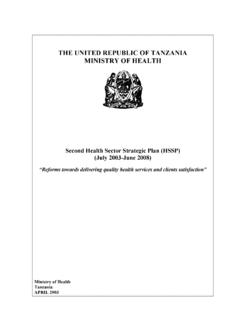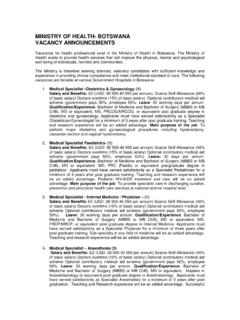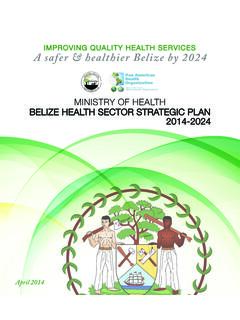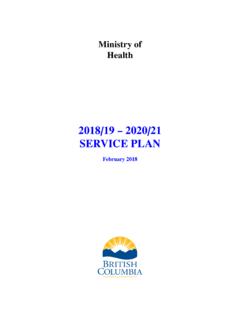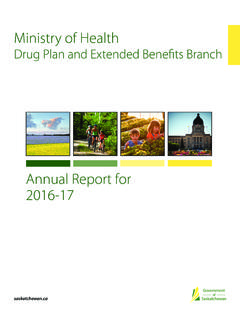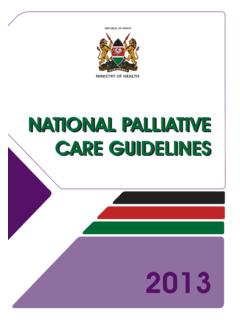Transcription of Ministry of Health - World Bank
1 Ministry of Health Health Sector Strategic Plan 2000/01 2004/05. TABLE OF CONTENTS Page Table of Contents 1. Acronyms 2. Executive Summary 3. CHAPTER 1: INTRODUCTION. Background 8. Situation Analysis 8. Health Sector Strategic Plan 14. CHAPTER 2: IMPLEMENTING THE UGANDA NATIONAL MINIMUM Health CARE PACKAGE. Introduction 15. Control of Communicable Diseases 16. Integrated Management of Childhood Illnesses 21. Sexual and Reproductive Health and Rights 24. Other Public Health Interventions 27. Immunisation 27. Environmental Health 30. Health Education and Promotion 33. School Health 35. Epidemics & Disaster Prevention, Preparedness and Response 37. Improving Nutrition 40. Interventions against diseases targeted for Eradication 43. Strengthening Mental Health Services 45. Essential clinical Care 47. CHAPTER 3: Health CARE DELIVERY SYSTEM. National Level Health Organisational and Management 52. Decentralised Health Care System 55.
2 Partnership with the Private sector in Health Services 58. Linkages and Inter-sectoral Collaboration 58. CHAPTER 4: INTEGRATED SUPPORT SYSTEMS. Human Resources Development and Management 60. Policy, Planning and Quality Assurance 63. Research and Development 66. Health Care Financing 68. Health Infrastructure Development and Maintenance 71. Procurement and Management of Drugs, Equipment, other Health Supplies and Logistics 74. Laboratory Support Services 77. Legal and Regulatory Framework 79. CHAPTER 5: COST AND FINANCING OF THE Health SECTOR STRATEGIC PLAN. Cost of Health Sector Strategic Plan 81. Financing the Health Sector Strategic Plan 88. CHAPTER 6: IMPLEMENTATION OF THE Health SECTOR STRATEGIC PLAN. Implementation of the HSSP 94. Monitoring and Evaluation of the HSSP 95. 1. ACRONYMS. AIDS Acquired Immuno-Deficiency Syndrome ARI Acute Respiratory Infections CDD Control of Diarrhoeal diseases CHW Community Health Worker DDHS District Director of Health Services DFID Department for International Development DHMT District Health Management Team DHOSP District Hospital DQE Drug Quantification Exercise DMO District Medical Officer DOTS Directly Observed Therapy DPT Diphtheria, Pertussis and Tetanus vaccine ENT Ear.
3 Nose and Throat EPI Expanded Program on Immunisation EU European Union FP Family Planning GDP Gross Domestic Product GHOSP Government Hospital GNP Gross National Product GOU Government of Uganda GTZ German Technical Organisation for Development Co-operation HC Health Centre HIS Health Information Systems HIV Human Immune-Deficiency Virus HMIS Health Management Information system HRD Human Resources Development HRH Human Resources for Health HSD Health sub-district HSSP Health Sector Strategic Plan IEC Information, Education and Communication IMCI Integrated Management of Childhood Illnesses KAPB Knowledge, Attitude, Practices and Behaviour MOH Ministry of Health MOLG Ministry of Local Government NGO Non-government Organisation PEAP Poverty Eradication Action Plan PEM Protein-Energy Malnutrition PHC Primary Health Care PWDs People with Disabilities QA Quality Assurance RH Reproductive Health STD Sexually Transmitted Diseases TB Tuberculosis TT Tetanus Toxoid TBA Traditional Birth Attendant UNEPI Uganda National Expanded Programme on Immunisation UNFPA United Nations Population Fund UNHRO Uganda National Health Research Organisation UNICEF United Nations Children's Fund USAID United States Agency for International Development WHO World Health Organisation 2.
4 EXECUTIVE SUMMARY. The Health Sector Strategic Plan (HSSP - 2000/1-2004/5) has been developed as a collaborative undertaking of the Ministry of Health , related ministries, the development partners and other stakeholders. The plan has been prepared within the framework of the Poverty Eradication Action Plan and Health sector policy. It describes the major technical Health programmes and support services and their outputs. The technical Health programmes arise from the minimum Health care package described in the policy, while the support services include Human Resources, policy and planning, quality assurance, information management system, research and development, Health infrastructure, procurement of drugs, equipment, supplies and logistics, Health care financing and legal and regulatory framework. The overall purpose of the Plan is to reduce morbidity and mortality from major causes of ill Health in Uganda and the disparities therein, as a contribution to poverty eradication and economic and social development of the people.
5 Health sector reforms, including decentralisation, have led to administrative and structural changes in the Health care delivery system. The district Health system will be used to deliver a package of Health services to the population of Uganda, while the Ministry of Health will be responsible for policy formulation, standards and guidelines, overall supervision and monitoring. In addition, it will ensure that strategic guidance, technical support and resources are made available to the districts and other Health care providers. The referral and other national level Health care institutions will provide the necessary back up support to the district Health services. The objectives of the plan are to: ! Relate the ongoing Health sector reforms to Health development. ! Provide a framework for three year rolling plans at all levels ! Involve all stakeholders in Health development. ! Exhibit a Health sector strategic framework, with coherent goals, objectives and targets for the next five years.
6 ! Indicate the level of investment in terms of costs required for achieving the policy objectives agreed upon by Government of Uganda and its development partners. ! Articulate the essential linkages between the various levels of the national Health care delivery system. The Strategic Plan is presented in a Logical Framework Matrix in figures I and II. The Overall Programme Goal and the Programme Purpose are presented at the top of the matrix. There are five major outputs of the Health Sector Strategic Plan. Below are the Outputs: ! Output 1 defines the minimum package of Health services. ! Output 2 describes the Health organisation and management system. ! Outputs 3 to 5 describe important support services that are necessary for the successful delivery and implementation of the minimum Health package. Each of these outputs consists of a number of major elements which when considered together will allow the output to be produced.
7 Figure I presents an overview of the plan, which outlines the elements that make up each output. Each of these elements is fully described in narrative form and supported by a Logical Framework Matrix in subsequent chapters. The elements have outputs and represent a broad guide for operational activities.. Within the extensively decentralised service delivery system in the country, and the nature 3. of the Budget Framework and the Medium Term Expenditure Framework (MTEF). formulation process, it is considered inappropriate to develop a detailed costed five year operational plan for the HSSP. Cost estimates for the five year plan are presented in Chapter Five. Detailed operational plans and budgets will be developed annually by the central implementing programmes and districts within the MTEF. The Ministry of Health will support the planning and implementation processes to ensure optimal use of resources within the framework of the minimum Health care package.
8 The indicative cost analysis for the Health Sector Strategic Plan shows a total cost figure of US$ 954 million. The annual total costs are US$ 159 million in Year 1, U$ 179 million in Year 2, US$ 207 million in Year 3, US$ 209 million in Year 4, and US$ 201 million in Year 5. The costs for delivering the Uganda Minimum Health Care Package are US$ 110 million in Year 1, US$ 117 million in Year 2, 138 million in Year 3, US$ 140 million in Year 4, and US$ 144 million in Year 5. They represent between 65% and 73% of annual total costs. The Health Sector Strategic Plan financing framework anticipates an indicative resource envelope of US$ 956 million and government allocation totalling US$ 344 million over the five-year period. Government of Uganda (GOU) resource as a percentage of recurrent cost will range from 42% in Year 1 to 55% in Year 5. The process of financial planning, programming and management requires commitment of all the stakeholders in the Health delivery system namely, the government, the donors, the private sector and the communities.
9 It is envisaged that government will seek support from development partners to redirect spending through a flexible budgetary support procedure. Furthermore, it would explore options for improving efficiency within the public Health sector. The implementation of the Health Sector Strategic Plan will be a dynamic process with constant refinement of the defined needs, modification of the minimum package, cost estimates and provision of financial resources for the Health service needs. Following the initial plan design, the next step will include further preliminary technical analysis and preparation of operational plans at all levels. In subsequent years, it is envisaged that the performance of the Health Sector Strategic Plan will be monitored twice yearly through the Joint Missions and will be subjected to mid-term review and re-appraisal. 4. Overview of programme Programme Goal Expanded Economic Growth Increased Social Development Poverty Eradication Programme Development Objective Reduced Morbidity and Mortality From major causes of ill Health and reduced disparity therein Program output 1 Program output 2 Program output 3 Program output 4 Program output 5.
10 Minimum Health Care Health Care Delivery Legal and regulatory Integrated support Policy, planning &. Package implemented, system strengthened framework systems strengthened information strengthened and and operational management system operational operational; Research and development implemented Elements Elements Elements Elements Elements 1. Control of 1 Restructured 1. Health Acts 1. Human Resources 1. Policy & Planning Communicable Ministry of Health for Health Diseases and support 2. Professional 2. Quality Assurance - Malaria institutions Councils 2. Health Care - STD/HIV/AIDS Financing 3. Health Information - TB 2. Decentralised 3. Private sector System 2. Integrated Health care regulated Management of delivery system 3. Health 4. Research and Childhood Illness 4. Traditional Infrastructure Development 3. Sexual and 3. Partnership with practitioners Reproductive private sector. regulated 4. Laboratory Health & Rights Services 4.










